Exploring the Need of Technology and Limits of Civilization
VerifiedAdded on 2023/01/18
|8
|2127
|58
Essay
AI Summary
This essay examines the proposition that human civilization has reached its technological limit, particularly with the advent of artificial intelligence. It argues that while significant advancements have been made, especially in areas like computation and communication, critical challenges such as climate change and pollution remain largely unresolved. The essay highlights that true technological zenith would only be achieved when all human problems can be addressed through technology, emphasizing the continuous need for innovation in environmental solutions and other areas to improve human life. Access more solved assignments and study resources on Desklib.
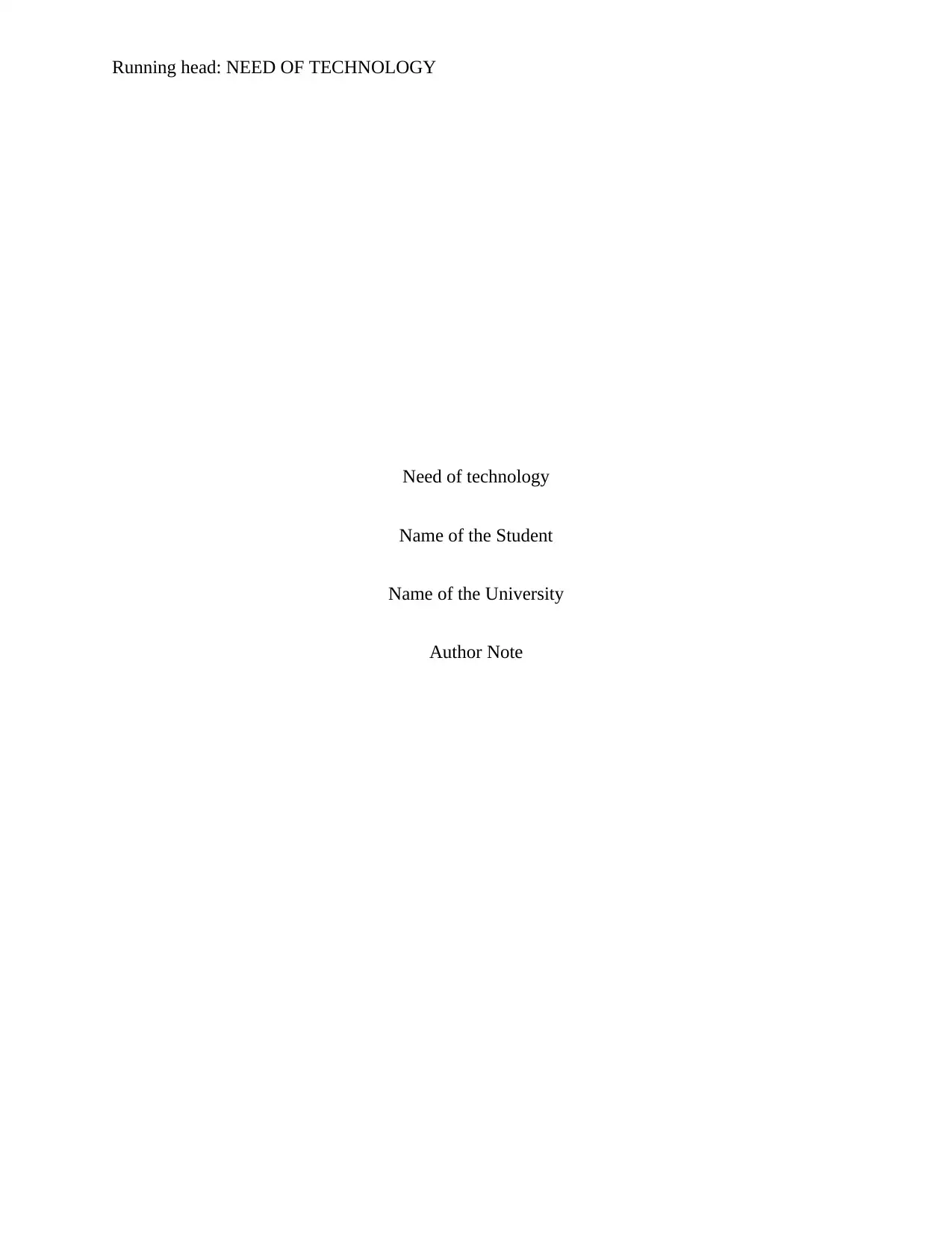
Running head: NEED OF TECHNOLOGY
Need of technology
Name of the Student
Name of the University
Author Note
Need of technology
Name of the Student
Name of the University
Author Note
Paraphrase This Document
Need a fresh take? Get an instant paraphrase of this document with our AI Paraphraser
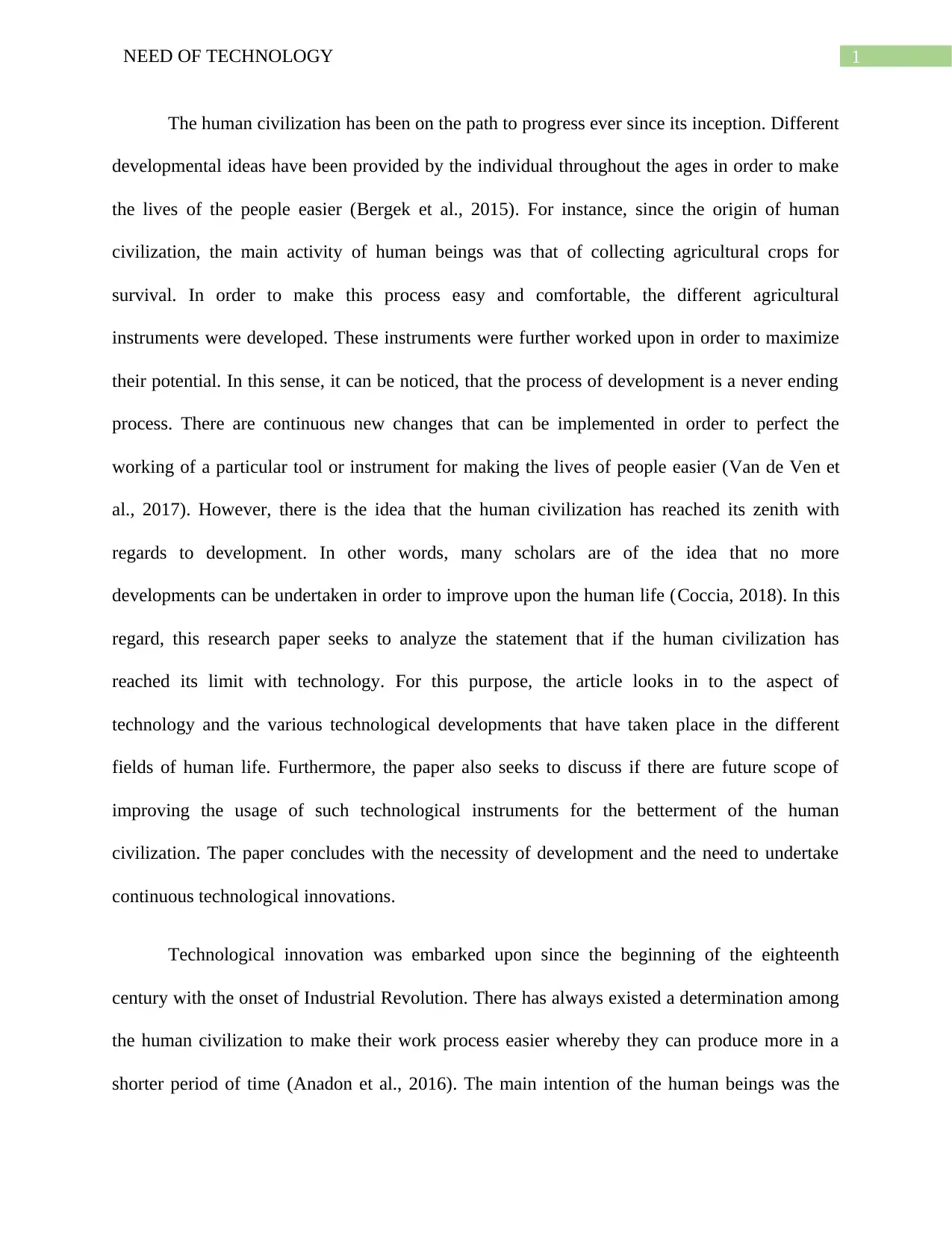
1NEED OF TECHNOLOGY
The human civilization has been on the path to progress ever since its inception. Different
developmental ideas have been provided by the individual throughout the ages in order to make
the lives of the people easier (Bergek et al., 2015). For instance, since the origin of human
civilization, the main activity of human beings was that of collecting agricultural crops for
survival. In order to make this process easy and comfortable, the different agricultural
instruments were developed. These instruments were further worked upon in order to maximize
their potential. In this sense, it can be noticed, that the process of development is a never ending
process. There are continuous new changes that can be implemented in order to perfect the
working of a particular tool or instrument for making the lives of people easier (Van de Ven et
al., 2017). However, there is the idea that the human civilization has reached its zenith with
regards to development. In other words, many scholars are of the idea that no more
developments can be undertaken in order to improve upon the human life (Coccia, 2018). In this
regard, this research paper seeks to analyze the statement that if the human civilization has
reached its limit with technology. For this purpose, the article looks in to the aspect of
technology and the various technological developments that have taken place in the different
fields of human life. Furthermore, the paper also seeks to discuss if there are future scope of
improving the usage of such technological instruments for the betterment of the human
civilization. The paper concludes with the necessity of development and the need to undertake
continuous technological innovations.
Technological innovation was embarked upon since the beginning of the eighteenth
century with the onset of Industrial Revolution. There has always existed a determination among
the human civilization to make their work process easier whereby they can produce more in a
shorter period of time (Anadon et al., 2016). The main intention of the human beings was the
The human civilization has been on the path to progress ever since its inception. Different
developmental ideas have been provided by the individual throughout the ages in order to make
the lives of the people easier (Bergek et al., 2015). For instance, since the origin of human
civilization, the main activity of human beings was that of collecting agricultural crops for
survival. In order to make this process easy and comfortable, the different agricultural
instruments were developed. These instruments were further worked upon in order to maximize
their potential. In this sense, it can be noticed, that the process of development is a never ending
process. There are continuous new changes that can be implemented in order to perfect the
working of a particular tool or instrument for making the lives of people easier (Van de Ven et
al., 2017). However, there is the idea that the human civilization has reached its zenith with
regards to development. In other words, many scholars are of the idea that no more
developments can be undertaken in order to improve upon the human life (Coccia, 2018). In this
regard, this research paper seeks to analyze the statement that if the human civilization has
reached its limit with technology. For this purpose, the article looks in to the aspect of
technology and the various technological developments that have taken place in the different
fields of human life. Furthermore, the paper also seeks to discuss if there are future scope of
improving the usage of such technological instruments for the betterment of the human
civilization. The paper concludes with the necessity of development and the need to undertake
continuous technological innovations.
Technological innovation was embarked upon since the beginning of the eighteenth
century with the onset of Industrial Revolution. There has always existed a determination among
the human civilization to make their work process easier whereby they can produce more in a
shorter period of time (Anadon et al., 2016). The main intention of the human beings was the
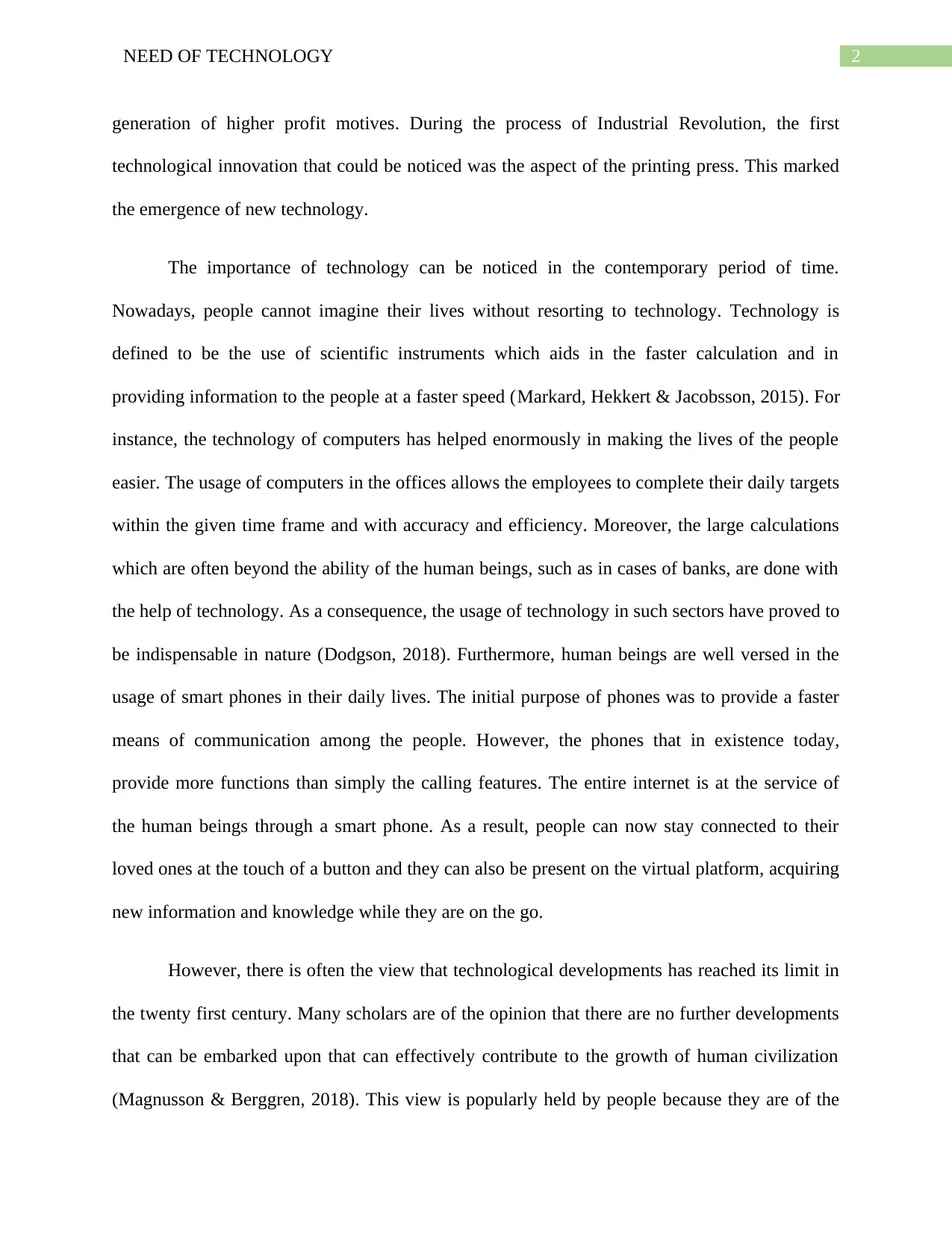
2NEED OF TECHNOLOGY
generation of higher profit motives. During the process of Industrial Revolution, the first
technological innovation that could be noticed was the aspect of the printing press. This marked
the emergence of new technology.
The importance of technology can be noticed in the contemporary period of time.
Nowadays, people cannot imagine their lives without resorting to technology. Technology is
defined to be the use of scientific instruments which aids in the faster calculation and in
providing information to the people at a faster speed (Markard, Hekkert & Jacobsson, 2015). For
instance, the technology of computers has helped enormously in making the lives of the people
easier. The usage of computers in the offices allows the employees to complete their daily targets
within the given time frame and with accuracy and efficiency. Moreover, the large calculations
which are often beyond the ability of the human beings, such as in cases of banks, are done with
the help of technology. As a consequence, the usage of technology in such sectors have proved to
be indispensable in nature (Dodgson, 2018). Furthermore, human beings are well versed in the
usage of smart phones in their daily lives. The initial purpose of phones was to provide a faster
means of communication among the people. However, the phones that in existence today,
provide more functions than simply the calling features. The entire internet is at the service of
the human beings through a smart phone. As a result, people can now stay connected to their
loved ones at the touch of a button and they can also be present on the virtual platform, acquiring
new information and knowledge while they are on the go.
However, there is often the view that technological developments has reached its limit in
the twenty first century. Many scholars are of the opinion that there are no further developments
that can be embarked upon that can effectively contribute to the growth of human civilization
(Magnusson & Berggren, 2018). This view is popularly held by people because they are of the
generation of higher profit motives. During the process of Industrial Revolution, the first
technological innovation that could be noticed was the aspect of the printing press. This marked
the emergence of new technology.
The importance of technology can be noticed in the contemporary period of time.
Nowadays, people cannot imagine their lives without resorting to technology. Technology is
defined to be the use of scientific instruments which aids in the faster calculation and in
providing information to the people at a faster speed (Markard, Hekkert & Jacobsson, 2015). For
instance, the technology of computers has helped enormously in making the lives of the people
easier. The usage of computers in the offices allows the employees to complete their daily targets
within the given time frame and with accuracy and efficiency. Moreover, the large calculations
which are often beyond the ability of the human beings, such as in cases of banks, are done with
the help of technology. As a consequence, the usage of technology in such sectors have proved to
be indispensable in nature (Dodgson, 2018). Furthermore, human beings are well versed in the
usage of smart phones in their daily lives. The initial purpose of phones was to provide a faster
means of communication among the people. However, the phones that in existence today,
provide more functions than simply the calling features. The entire internet is at the service of
the human beings through a smart phone. As a result, people can now stay connected to their
loved ones at the touch of a button and they can also be present on the virtual platform, acquiring
new information and knowledge while they are on the go.
However, there is often the view that technological developments has reached its limit in
the twenty first century. Many scholars are of the opinion that there are no further developments
that can be embarked upon that can effectively contribute to the growth of human civilization
(Magnusson & Berggren, 2018). This view is popularly held by people because they are of the
⊘ This is a preview!⊘
Do you want full access?
Subscribe today to unlock all pages.

Trusted by 1+ million students worldwide
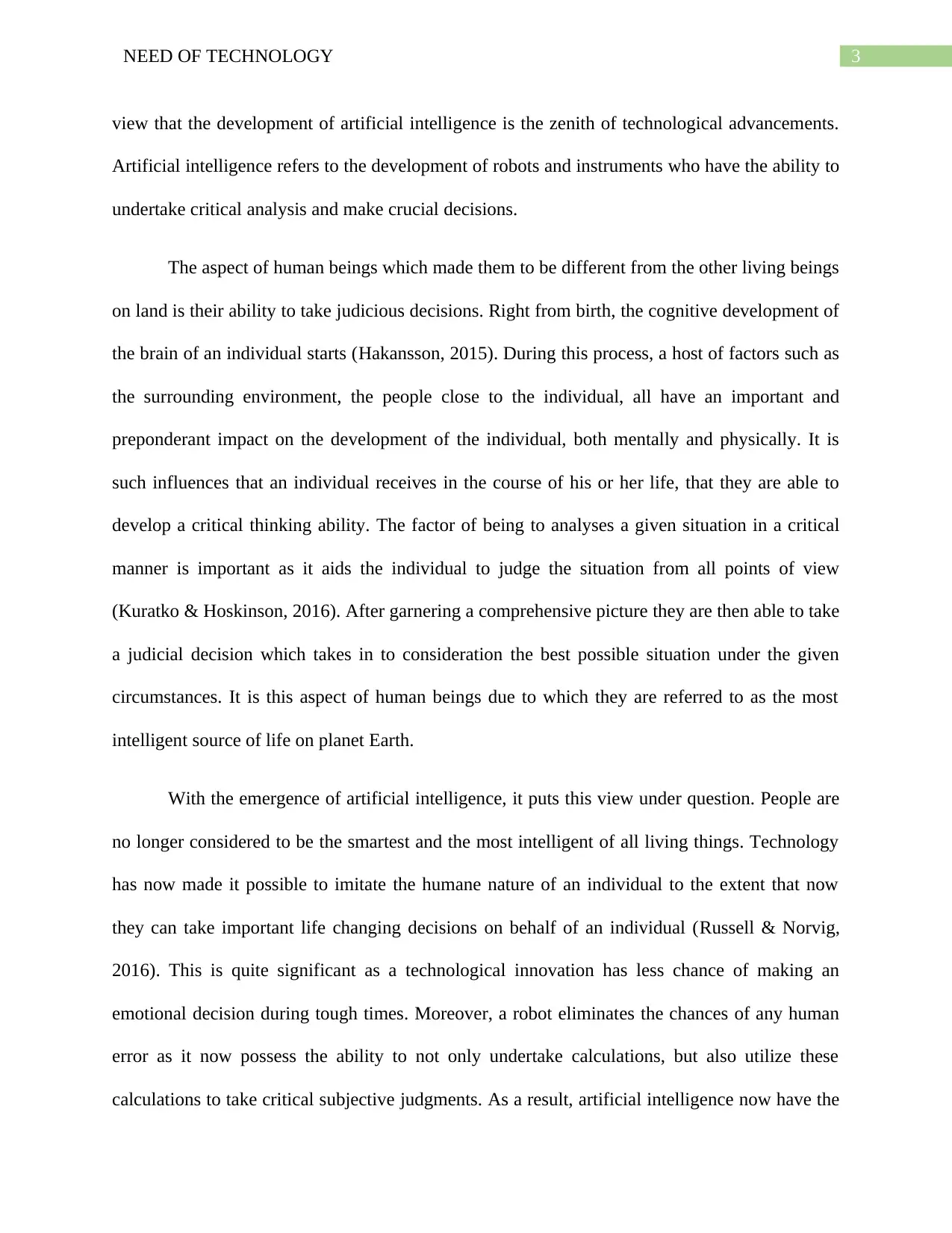
3NEED OF TECHNOLOGY
view that the development of artificial intelligence is the zenith of technological advancements.
Artificial intelligence refers to the development of robots and instruments who have the ability to
undertake critical analysis and make crucial decisions.
The aspect of human beings which made them to be different from the other living beings
on land is their ability to take judicious decisions. Right from birth, the cognitive development of
the brain of an individual starts (Hakansson, 2015). During this process, a host of factors such as
the surrounding environment, the people close to the individual, all have an important and
preponderant impact on the development of the individual, both mentally and physically. It is
such influences that an individual receives in the course of his or her life, that they are able to
develop a critical thinking ability. The factor of being to analyses a given situation in a critical
manner is important as it aids the individual to judge the situation from all points of view
(Kuratko & Hoskinson, 2016). After garnering a comprehensive picture they are then able to take
a judicial decision which takes in to consideration the best possible situation under the given
circumstances. It is this aspect of human beings due to which they are referred to as the most
intelligent source of life on planet Earth.
With the emergence of artificial intelligence, it puts this view under question. People are
no longer considered to be the smartest and the most intelligent of all living things. Technology
has now made it possible to imitate the humane nature of an individual to the extent that now
they can take important life changing decisions on behalf of an individual (Russell & Norvig,
2016). This is quite significant as a technological innovation has less chance of making an
emotional decision during tough times. Moreover, a robot eliminates the chances of any human
error as it now possess the ability to not only undertake calculations, but also utilize these
calculations to take critical subjective judgments. As a result, artificial intelligence now have the
view that the development of artificial intelligence is the zenith of technological advancements.
Artificial intelligence refers to the development of robots and instruments who have the ability to
undertake critical analysis and make crucial decisions.
The aspect of human beings which made them to be different from the other living beings
on land is their ability to take judicious decisions. Right from birth, the cognitive development of
the brain of an individual starts (Hakansson, 2015). During this process, a host of factors such as
the surrounding environment, the people close to the individual, all have an important and
preponderant impact on the development of the individual, both mentally and physically. It is
such influences that an individual receives in the course of his or her life, that they are able to
develop a critical thinking ability. The factor of being to analyses a given situation in a critical
manner is important as it aids the individual to judge the situation from all points of view
(Kuratko & Hoskinson, 2016). After garnering a comprehensive picture they are then able to take
a judicial decision which takes in to consideration the best possible situation under the given
circumstances. It is this aspect of human beings due to which they are referred to as the most
intelligent source of life on planet Earth.
With the emergence of artificial intelligence, it puts this view under question. People are
no longer considered to be the smartest and the most intelligent of all living things. Technology
has now made it possible to imitate the humane nature of an individual to the extent that now
they can take important life changing decisions on behalf of an individual (Russell & Norvig,
2016). This is quite significant as a technological innovation has less chance of making an
emotional decision during tough times. Moreover, a robot eliminates the chances of any human
error as it now possess the ability to not only undertake calculations, but also utilize these
calculations to take critical subjective judgments. As a result, artificial intelligence now have the
Paraphrase This Document
Need a fresh take? Get an instant paraphrase of this document with our AI Paraphraser
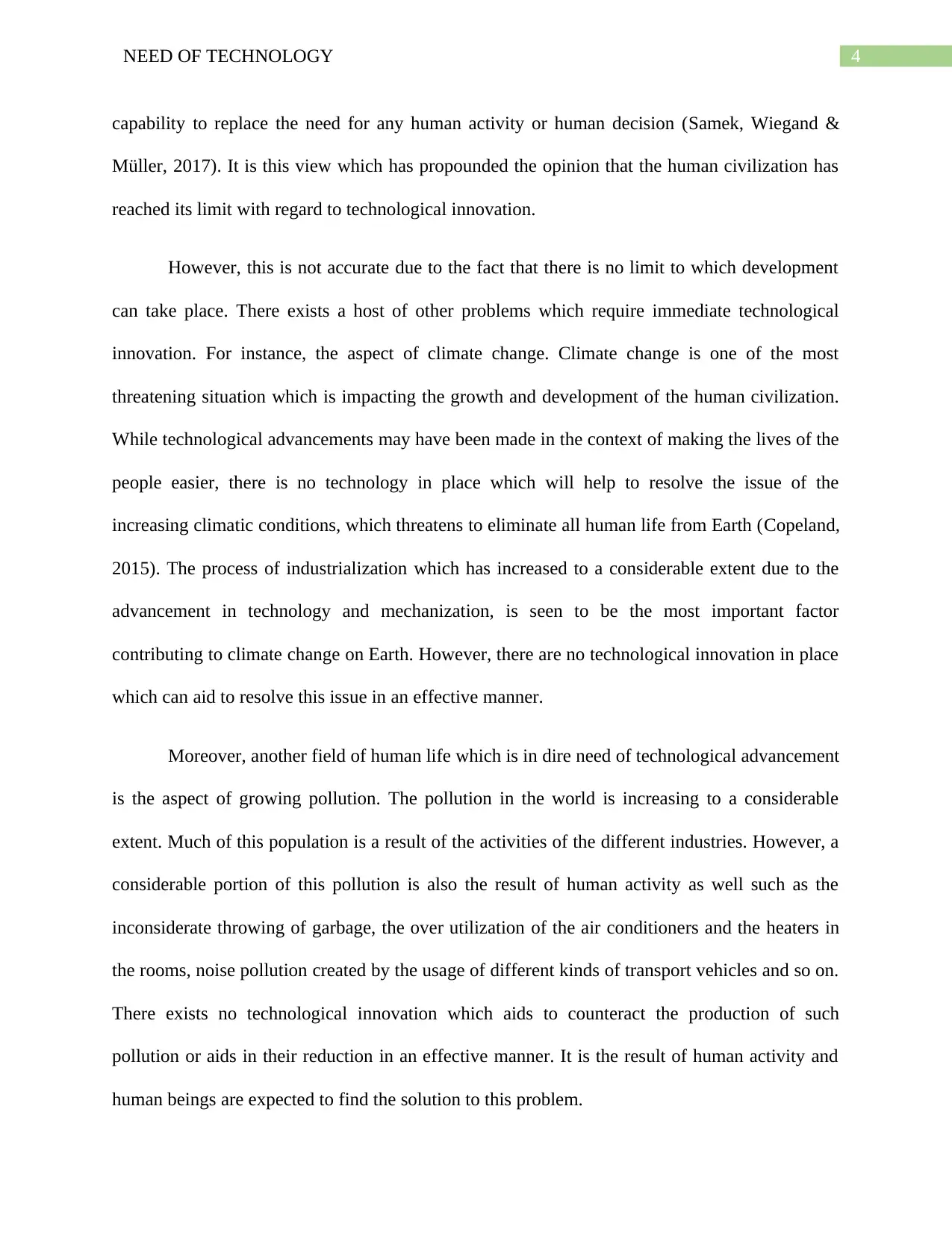
4NEED OF TECHNOLOGY
capability to replace the need for any human activity or human decision (Samek, Wiegand &
Müller, 2017). It is this view which has propounded the opinion that the human civilization has
reached its limit with regard to technological innovation.
However, this is not accurate due to the fact that there is no limit to which development
can take place. There exists a host of other problems which require immediate technological
innovation. For instance, the aspect of climate change. Climate change is one of the most
threatening situation which is impacting the growth and development of the human civilization.
While technological advancements may have been made in the context of making the lives of the
people easier, there is no technology in place which will help to resolve the issue of the
increasing climatic conditions, which threatens to eliminate all human life from Earth (Copeland,
2015). The process of industrialization which has increased to a considerable extent due to the
advancement in technology and mechanization, is seen to be the most important factor
contributing to climate change on Earth. However, there are no technological innovation in place
which can aid to resolve this issue in an effective manner.
Moreover, another field of human life which is in dire need of technological advancement
is the aspect of growing pollution. The pollution in the world is increasing to a considerable
extent. Much of this population is a result of the activities of the different industries. However, a
considerable portion of this pollution is also the result of human activity as well such as the
inconsiderate throwing of garbage, the over utilization of the air conditioners and the heaters in
the rooms, noise pollution created by the usage of different kinds of transport vehicles and so on.
There exists no technological innovation which aids to counteract the production of such
pollution or aids in their reduction in an effective manner. It is the result of human activity and
human beings are expected to find the solution to this problem.
capability to replace the need for any human activity or human decision (Samek, Wiegand &
Müller, 2017). It is this view which has propounded the opinion that the human civilization has
reached its limit with regard to technological innovation.
However, this is not accurate due to the fact that there is no limit to which development
can take place. There exists a host of other problems which require immediate technological
innovation. For instance, the aspect of climate change. Climate change is one of the most
threatening situation which is impacting the growth and development of the human civilization.
While technological advancements may have been made in the context of making the lives of the
people easier, there is no technology in place which will help to resolve the issue of the
increasing climatic conditions, which threatens to eliminate all human life from Earth (Copeland,
2015). The process of industrialization which has increased to a considerable extent due to the
advancement in technology and mechanization, is seen to be the most important factor
contributing to climate change on Earth. However, there are no technological innovation in place
which can aid to resolve this issue in an effective manner.
Moreover, another field of human life which is in dire need of technological advancement
is the aspect of growing pollution. The pollution in the world is increasing to a considerable
extent. Much of this population is a result of the activities of the different industries. However, a
considerable portion of this pollution is also the result of human activity as well such as the
inconsiderate throwing of garbage, the over utilization of the air conditioners and the heaters in
the rooms, noise pollution created by the usage of different kinds of transport vehicles and so on.
There exists no technological innovation which aids to counteract the production of such
pollution or aids in their reduction in an effective manner. It is the result of human activity and
human beings are expected to find the solution to this problem.
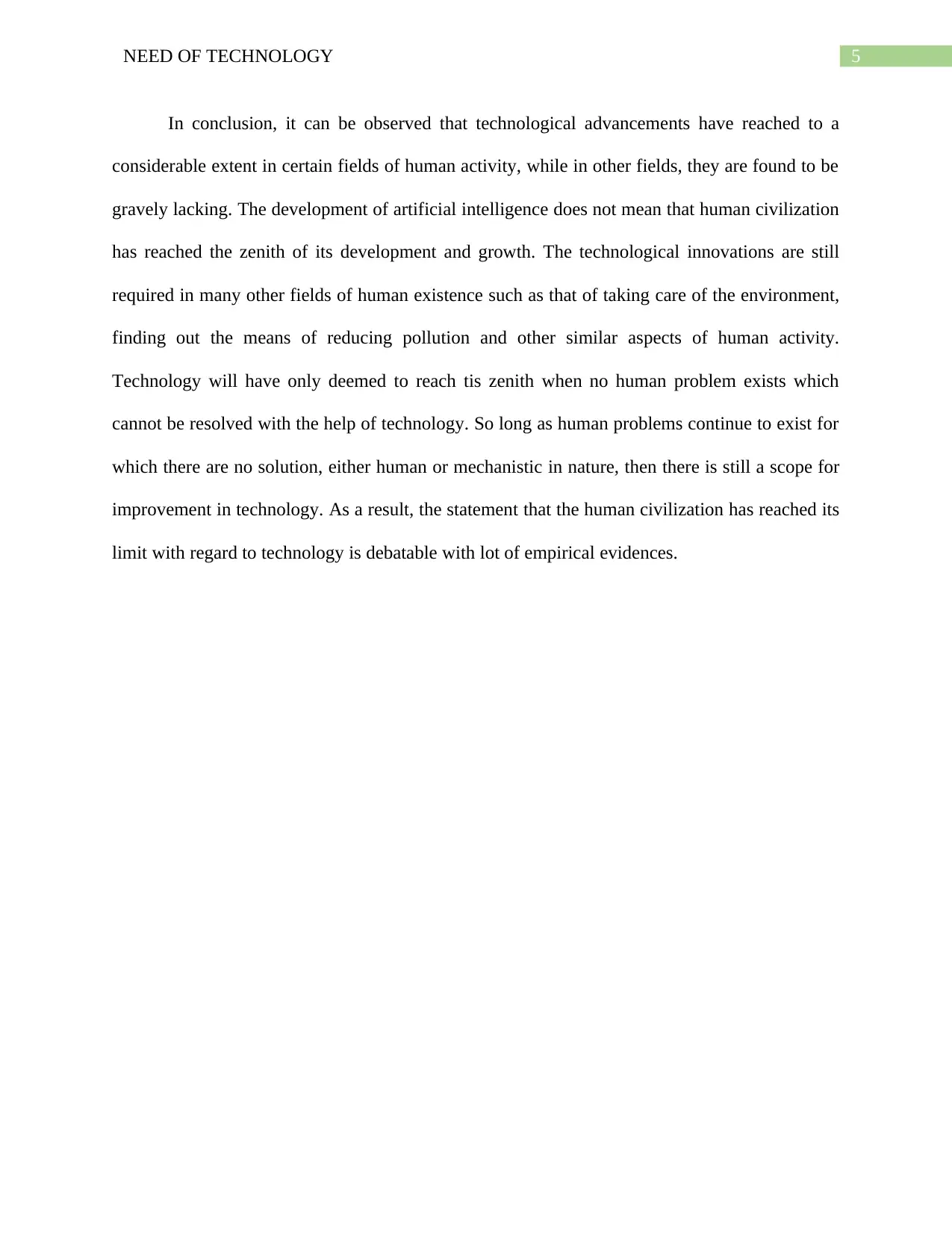
5NEED OF TECHNOLOGY
In conclusion, it can be observed that technological advancements have reached to a
considerable extent in certain fields of human activity, while in other fields, they are found to be
gravely lacking. The development of artificial intelligence does not mean that human civilization
has reached the zenith of its development and growth. The technological innovations are still
required in many other fields of human existence such as that of taking care of the environment,
finding out the means of reducing pollution and other similar aspects of human activity.
Technology will have only deemed to reach tis zenith when no human problem exists which
cannot be resolved with the help of technology. So long as human problems continue to exist for
which there are no solution, either human or mechanistic in nature, then there is still a scope for
improvement in technology. As a result, the statement that the human civilization has reached its
limit with regard to technology is debatable with lot of empirical evidences.
In conclusion, it can be observed that technological advancements have reached to a
considerable extent in certain fields of human activity, while in other fields, they are found to be
gravely lacking. The development of artificial intelligence does not mean that human civilization
has reached the zenith of its development and growth. The technological innovations are still
required in many other fields of human existence such as that of taking care of the environment,
finding out the means of reducing pollution and other similar aspects of human activity.
Technology will have only deemed to reach tis zenith when no human problem exists which
cannot be resolved with the help of technology. So long as human problems continue to exist for
which there are no solution, either human or mechanistic in nature, then there is still a scope for
improvement in technology. As a result, the statement that the human civilization has reached its
limit with regard to technology is debatable with lot of empirical evidences.
⊘ This is a preview!⊘
Do you want full access?
Subscribe today to unlock all pages.

Trusted by 1+ million students worldwide
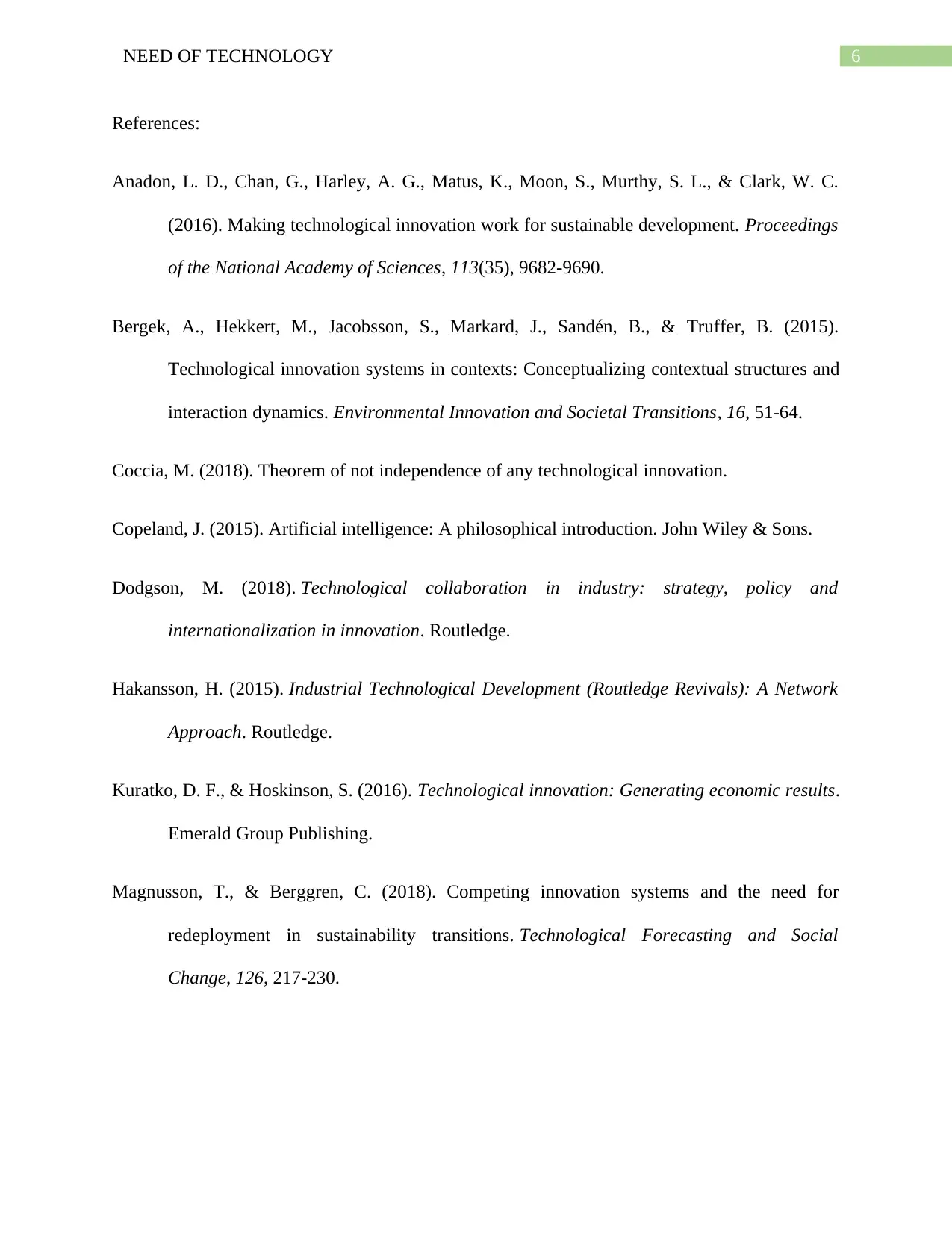
6NEED OF TECHNOLOGY
References:
Anadon, L. D., Chan, G., Harley, A. G., Matus, K., Moon, S., Murthy, S. L., & Clark, W. C.
(2016). Making technological innovation work for sustainable development. Proceedings
of the National Academy of Sciences, 113(35), 9682-9690.
Bergek, A., Hekkert, M., Jacobsson, S., Markard, J., Sandén, B., & Truffer, B. (2015).
Technological innovation systems in contexts: Conceptualizing contextual structures and
interaction dynamics. Environmental Innovation and Societal Transitions, 16, 51-64.
Coccia, M. (2018). Theorem of not independence of any technological innovation.
Copeland, J. (2015). Artificial intelligence: A philosophical introduction. John Wiley & Sons.
Dodgson, M. (2018). Technological collaboration in industry: strategy, policy and
internationalization in innovation. Routledge.
Hakansson, H. (2015). Industrial Technological Development (Routledge Revivals): A Network
Approach. Routledge.
Kuratko, D. F., & Hoskinson, S. (2016). Technological innovation: Generating economic results.
Emerald Group Publishing.
Magnusson, T., & Berggren, C. (2018). Competing innovation systems and the need for
redeployment in sustainability transitions. Technological Forecasting and Social
Change, 126, 217-230.
References:
Anadon, L. D., Chan, G., Harley, A. G., Matus, K., Moon, S., Murthy, S. L., & Clark, W. C.
(2016). Making technological innovation work for sustainable development. Proceedings
of the National Academy of Sciences, 113(35), 9682-9690.
Bergek, A., Hekkert, M., Jacobsson, S., Markard, J., Sandén, B., & Truffer, B. (2015).
Technological innovation systems in contexts: Conceptualizing contextual structures and
interaction dynamics. Environmental Innovation and Societal Transitions, 16, 51-64.
Coccia, M. (2018). Theorem of not independence of any technological innovation.
Copeland, J. (2015). Artificial intelligence: A philosophical introduction. John Wiley & Sons.
Dodgson, M. (2018). Technological collaboration in industry: strategy, policy and
internationalization in innovation. Routledge.
Hakansson, H. (2015). Industrial Technological Development (Routledge Revivals): A Network
Approach. Routledge.
Kuratko, D. F., & Hoskinson, S. (2016). Technological innovation: Generating economic results.
Emerald Group Publishing.
Magnusson, T., & Berggren, C. (2018). Competing innovation systems and the need for
redeployment in sustainability transitions. Technological Forecasting and Social
Change, 126, 217-230.
Paraphrase This Document
Need a fresh take? Get an instant paraphrase of this document with our AI Paraphraser
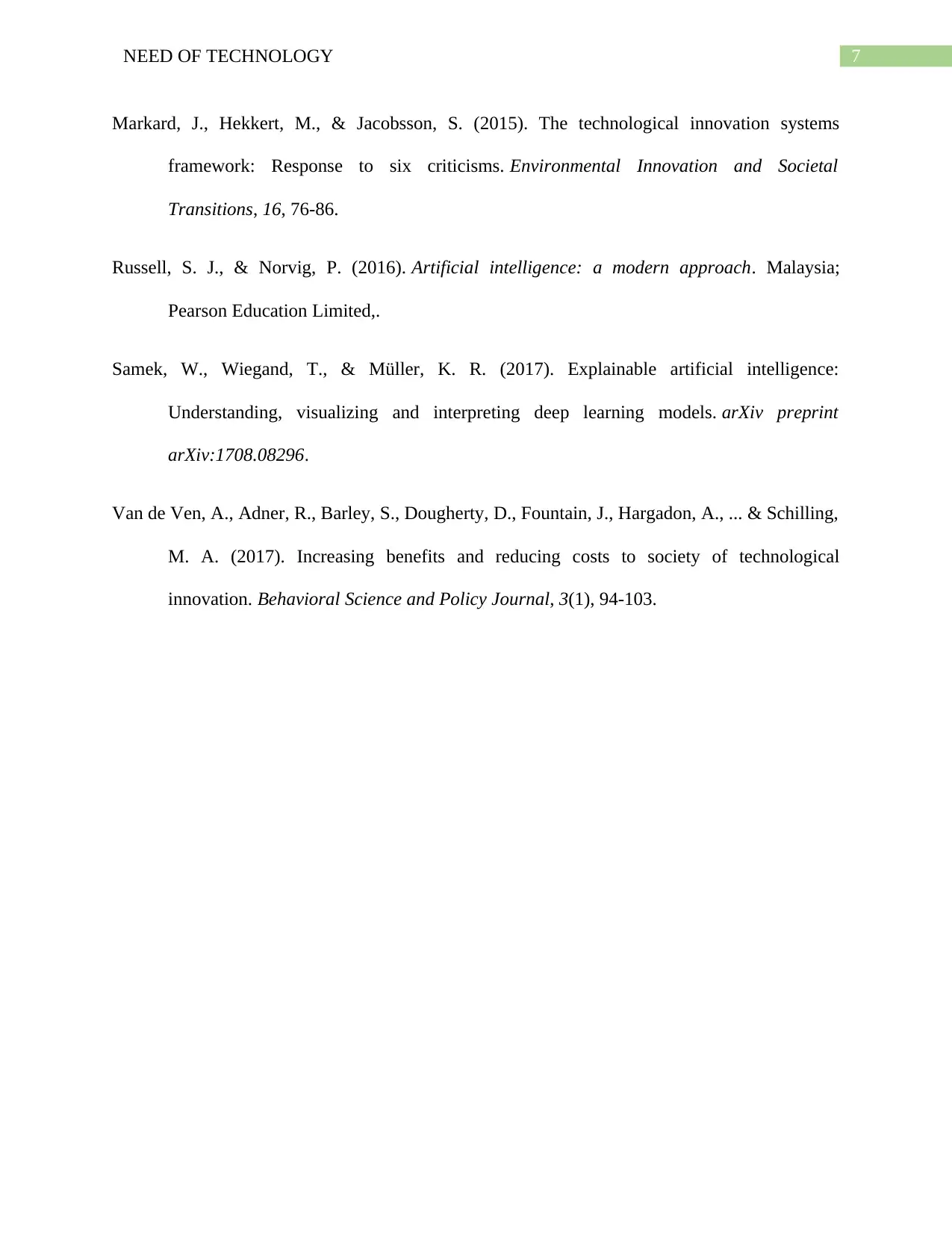
7NEED OF TECHNOLOGY
Markard, J., Hekkert, M., & Jacobsson, S. (2015). The technological innovation systems
framework: Response to six criticisms. Environmental Innovation and Societal
Transitions, 16, 76-86.
Russell, S. J., & Norvig, P. (2016). Artificial intelligence: a modern approach. Malaysia;
Pearson Education Limited,.
Samek, W., Wiegand, T., & Müller, K. R. (2017). Explainable artificial intelligence:
Understanding, visualizing and interpreting deep learning models. arXiv preprint
arXiv:1708.08296.
Van de Ven, A., Adner, R., Barley, S., Dougherty, D., Fountain, J., Hargadon, A., ... & Schilling,
M. A. (2017). Increasing benefits and reducing costs to society of technological
innovation. Behavioral Science and Policy Journal, 3(1), 94-103.
Markard, J., Hekkert, M., & Jacobsson, S. (2015). The technological innovation systems
framework: Response to six criticisms. Environmental Innovation and Societal
Transitions, 16, 76-86.
Russell, S. J., & Norvig, P. (2016). Artificial intelligence: a modern approach. Malaysia;
Pearson Education Limited,.
Samek, W., Wiegand, T., & Müller, K. R. (2017). Explainable artificial intelligence:
Understanding, visualizing and interpreting deep learning models. arXiv preprint
arXiv:1708.08296.
Van de Ven, A., Adner, R., Barley, S., Dougherty, D., Fountain, J., Hargadon, A., ... & Schilling,
M. A. (2017). Increasing benefits and reducing costs to society of technological
innovation. Behavioral Science and Policy Journal, 3(1), 94-103.
1 out of 8
Related Documents
Your All-in-One AI-Powered Toolkit for Academic Success.
+13062052269
info@desklib.com
Available 24*7 on WhatsApp / Email
![[object Object]](/_next/static/media/star-bottom.7253800d.svg)
Unlock your academic potential
Copyright © 2020–2025 A2Z Services. All Rights Reserved. Developed and managed by ZUCOL.





